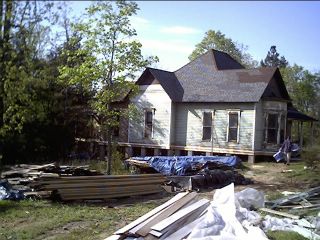1. Never Hire Family. Paying family to work on your house, even if they are carpenters or professional contractors, is a lose lose situation. It will be more difficult to confront your family member for shoddy workmanship or to demand time frames. On the other side, your family member will feel that your work is not priority and that you are lenient, causing him or her to work more slowly and possibly charge hourly. I once hired a family member whom I thought would give me a good deal on labor. In exchange, I agreed to allow him to charge an hourly rate. I ended up paying him over half of what the bank loaned us (over a four-month period) and none of the projects were close to being finished. I finally fired them and hired a man who could work a project rate.
2. Never Pay an Hourly Rate. Always get estimates by the job. Anyone who is unwilling to give you a rate by the job is out to screw you over. So unless you can show up at 6 or 7 a.m. everyday and work alongside the crew until they go home, you need a rate per job. Per rate jobs are also easier to compare than hourly rates. Plus they are much less flexible, which is a benefit for anyone on a budget.
3. Keep Tabs on All Materials. Don’t let your workers “just get what you need.” Make sure you know what you need and price the material at a couple of building supply stores. If a worker picks anything up for you, get a receipt. Also, most workers will add such things as nails into their job quote. And make sure to count and to check all delivered materials. I once hired a man who worked on multiple houses at once. Not only did he always buy at the most expensive place in town, he charged me for materials he took and used on other people’s houses. If I hadn’t counted all the supplies used while he was working for me, I would have had to pay about $1,000 in materials that would never reach my house.
4. Build Up Your Contacts by Asking Local Building Retailers for References or Hit The Road. When I first started, I asked all the supply stores (Lowes, RideOut Lumber, Lumberlands, National Home Center, etc.) who they recommended for different projects. I built up names, calling the ones whose names came up the most first. If they couldn’t take a project, I asked them if they knew someone who could. I also kept all the names and numbers I ever got in a little black book and put notes beside them. (i.e. bad, or mason *) If you get nowhere fast with that tactic, go for a joyride through a developing subdivision or rejuvenating historic area. My favorite workers were found after I saw them working on a Queen Ann Victorian home in Clarksville, Ark. I stopped the car and went inside, inspected the work and asked for their names and numbers. Workers will often recommend people they’ve worked with who are proficient in other building avenues. I have a bulldozer man who recommended an excellent foundation and concrete man he had worked with previously. (Bill’s Backhoe Service and Avrom Clow, both of Atkins, Ark.) Together, they built me a very fine foundation with rebar to which my house was moved.
5. Be Pleasant, But Persistent. My rule is the three times rule. Call potential workers three times, but after the third time, if they don’t call back then they don’t want the work. If they say they’ll show up, but don’t, then they don’t want the work. If you’ve already hired them and they only work one day per month for three months, fire them. (This doesn’t count weather or acts of God.)
6. The More You Save in Materials, the Longer You Can Afford Your Workers. If you are on a budget, and I’m on a tight one, you’ll realize quickly that the more you can save the more projects you can pay someone else to do. The easiest place to save is in materials. Read the newspapers for building supplies and auctions and yard sales. I bought a bunch of my electric wire from a retiring electrician. Ebay always has used and new materials for sale, everything from doors with transoms to Kohl facets. Flea markets and salvage yards also have period supplies at a lower price than some reproductions. And, if you’re up to the work, there is always tearing down houses for supplies. Wood flooring, bead board, lights, cast-iron sinks, are just some of the items we got in exchange for sweat and blood. Plus, some salvage yards will exchange items you can’t use for ones you can. We exchanged our cast iron inserts for windows that matched the originals on our house.
7. Research, Research, Research. Always know how something is done in principle; it’s the only way to know whether the worker you are about to hire really knows what he is doing or if he is just trying to take advantage. Read books on each project. This way you can be sure the project will be done correctly, and you won’t have to pay five years down the road to have the entire thing redone. It is also good to look at portfolios and call references if you can get them.
8. ShowUp and Inspect the Work Once a Day. The workers don’t have to be present, but it is important to stay abreast of the work. This way you can be sure you’re getting your moneys worth. And it will be easier to catch mistakes.
9. Price at Least Two, Preferably Three People Per Job. Although you don’t always want the lowest bid, you definitely want to know what everyone else is charging. A guy from the newspaper gave me an estimate of $9,000 for building my fireplace, but the mason recommended by another carpenter and who was working on several other houses in our subdivision, gave me an estimate of $2,500. Who do you think I hired? A lot of carpenters will give women higher prices than men, so it’s best to know who is trying to screw you. The first roofer I asked for an estimate for removing our hipped roof on our Victorian quoted $25,000, but I had already talked to another carpenter who could do it for $3,200. It’s also easier to haggle prices if you’ve already had a couple of bids. One roofer gave me a low estimate for putting a tin roof on a ranch house, so I haggled the next estimate down a hundred lower. This was great for me because I had worked with both men and knew they were both good.
10. Don’t Ask Workers to “While You’re At It…” Separate projects get separate quotes. If the carpenter finishes, then is the time to ask him or her to approach another. Otherwise the price will go up uncontrollably because you will have given up your power, allowing the worker to just add a fee or to charge an hour rate for the additional projects.
- Posted by Miss Scarlet





















